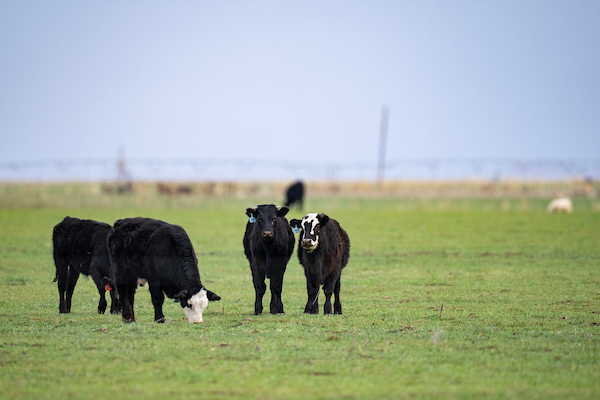Dry spell weighs on Texas’ cool-season forage planting – AgriLife Today

Report on the Impact of Drought on Texas Forage Production and Alignment with Sustainable Development Goals
1.0 Executive Summary: Climate Change and Food Security Challenges
Recent drought trends across Texas are presenting significant challenges to cattle producers, directly impacting regional food production systems and highlighting the urgent need for climate-resilient agricultural practices. As producers evaluate options for cool-season forage planting, their decisions intersect with several key United Nations Sustainable Development Goals (SDGs), particularly those concerning food security, climate action, and sustainable land use. This report analyzes the current situation, expert opinions, and climatological forecasts through the lens of the SDGs.
2.0 Analysis of Environmental Conditions and Climate Action (SDG 13)
The prevailing dry conditions are a critical concern, reflecting broader climate patterns that demand immediate attention under SDG 13 (Climate Action). The state’s agricultural sector is grappling with the direct consequences of climate variability.
- Worsening Drought: Data from the U.S. Drought Monitor indicates a significant reversal of summer gains. As of September 30, 63% of Texas was experiencing drought, a stark increase from 38% on July 1. This rapid deterioration underscores the vulnerability of the region to climatic shifts.
- La Niña Forecast: Climatological predictions indicate a persistent weak La Niña system, which increases the probability of a warmer and drier fall and winter. This forecast complicates efforts to achieve agricultural stability and necessitates proactive adaptation strategies.
- Declining Soil Moisture: Statewide soil moisture levels have declined, leaving fields unprepared for planting. This lack of water resources is a primary impediment to forage production and a direct challenge to sustainable water management, linking to SDG 6 (Clean Water and Sanitation).
3.0 Impact on Food Production and Zero Hunger (SDG 2)
The disruption to forage planting directly threatens the livestock sector, a cornerstone of the regional food supply chain. This situation poses a risk to achieving SDG 2 (Zero Hunger) by jeopardizing the stability of food production.
- Delayed Planting: Producers across East, South, and the High Plains of Texas are delaying or forgoing the planting of cool-season forages like small grains and ryegrass due to insufficient soil moisture.
- Reliance on Hay Reserves: While good spring and summer moisture led to ample hay supplies, relying solely on stored forage presents risks. Dr. Vanessa Corriher-Olson warns that producers may face shortages or discover low nutritional quality in their hay stocks later in the winter, when alternative planting options are no longer viable.
- Threat to Livestock Nutrition: Cool-season forages provide essential nutrition for livestock, including dairy and feedlot operations. A failure to establish these crops could lead to nutritional deficits, impacting animal health and productivity, thereby undermining the goals of responsible and sustainable production under SDG 12.
4.0 Sustainable Land Management and Production Practices (SDG 15 & SDG 12)
Producer decisions in response to the drought are a critical aspect of land management and sustainable production. These choices have long-term implications for the health of terrestrial ecosystems, a core focus of SDG 15 (Life on Land).
- Risk Assessment: The choice between planting into dry soil (a risk to seed and resources) and relying on stored hay reflects a complex risk assessment. This decision-making process is central to developing sustainable production patterns as outlined in SDG 12 (Responsible Consumption and Production).
- Agronomic Recommendations: Experts like Dr. Jourdan Bell advise producers with any available moisture to plant immediately to maximize the growing window. This guidance promotes the efficient use of natural resources.
- Integrated Pest Management: Producers are advised to scout for fall armyworms, especially in newly emerged seedlings. This practice is a component of sustainable agriculture, minimizing crop loss while reducing reliance on broad-spectrum interventions, thus protecting biodiversity and ecosystem health (SDG 15).
5.0 Forward-Looking Strategies for Agricultural Resilience
To mitigate the impacts of climate change and ensure progress toward the SDGs, producers must consider adaptive strategies. The current planting window, though narrowing, still offers opportunities for action.
- Timely Planting: Planting cool-season forages approximately six weeks before the average first frost (mid-to-late October in many areas) offers the best chance for establishment and growth.
- Flexible Crop Selection: Annual ryegrass remains a viable option for later plantings, particularly in regions east of Interstate 35, offering flexibility in forage planning.
- Strategic Planning: Producers must weigh the costs of seed and fertilizer against the potential benefits of winter grazing to make economically and environmentally sound decisions that support long-term sustainability and food security.
Analysis of Sustainable Development Goals in the Article
1. Which SDGs are addressed or connected to the issues highlighted in the article?
-
SDG 2: Zero Hunger
The article focuses on cattle production, which is a key component of the food supply chain. The challenges of growing forage and ensuring feed for livestock due to drought directly impact food security and the sustainability of food production systems.
-
SDG 6: Clean Water and Sanitation
While not about sanitation, the article is fundamentally about water scarcity. The “extended dry period,” “lack of moisture,” and declining “soil moisture levels” are central themes, highlighting the challenges of managing water resources for agriculture in the face of drought.
-
SDG 13: Climate Action
The article explicitly links the drought conditions to climate patterns, mentioning the forecast of a “weak La Niña system” that will bring “warmer temperatures and fewer chances of rainfall.” This demonstrates the direct impact of climate-related phenomena on agriculture and the need for adaptation strategies.
-
SDG 15: Life on Land
The discussion revolves around the health and productivity of terrestrial ecosystems, such as “pastures,” “fields,” and “native rangeland.” The drought conditions described are a form of land degradation and desertification, impacting the sustainable management of land used for grazing and agriculture.
2. What specific targets under those SDGs can be identified based on the article’s content?
-
Target 2.4
“By 2030, ensure sustainable food production systems and implement resilient agricultural practices that increase productivity and production, that help maintain ecosystems, that strengthen capacity for adaptation to climate change, extreme weather, drought, flooding and other disasters and that progressively improve land and soil quality.”
The article details how Texas cattle producers are adapting their practices (delaying planting, relying on hay stocks, considering different forage types like annual ryegrass) in response to drought, which is an extreme weather event. This is a direct example of attempting to implement resilient agricultural practices to sustain livestock production.
-
Target 6.4
“By 2030, substantially increase water-use efficiency across all sectors and ensure sustainable withdrawals and supply of freshwater to address water scarcity and substantially reduce the number of people suffering from water scarcity.”
The article highlights the issue of water scarcity impacting a critical sector—agriculture. The producers’ decisions are entirely dependent on the availability of rainwater and soil moisture, underscoring the challenge of addressing water scarcity to maintain agricultural output.
-
Target 13.1
“Strengthen resilience and adaptive capacity to climate-related hazards and natural disasters in all countries.”
The entire article is a case study of agricultural producers assessing climate-related hazards (drought, La Niña forecast) and adjusting their strategies to build resilience. The advice from AgriLife Extension specialists on planting windows and forage options represents efforts to strengthen this adaptive capacity.
-
Target 15.3
“By 2030, combat desertification, restore degraded land and soil, including land affected by desertification, drought and floods, and strive to achieve a land degradation-neutral world.”
The article describes land affected by drought, with “pastures and fields typically planted with cool-season forages for winter grazing sitting idle.” The data from the U.S. Drought Monitor showing 63% of the state experiencing drought quantifies the extent of land affected by this issue, which is a key component of this target.
3. Are there any indicators mentioned or implied in the article that can be used to measure progress towards the identified targets?
-
U.S. Drought Monitor Data
The article explicitly mentions this indicator: “The U.S. Drought Monitor showed summer rains reversed dry conditions across much of the state. On July 1, around 62% of the state reported no level of drought, while the Sept. 30 report showed 63% of the state was experiencing drought.” This directly measures the proportion of land degraded by drought (relevant to Target 15.3) and the severity of water scarcity (relevant to Target 6.4).
-
Soil Moisture Levels
The article repeatedly refers to “soil moisture levels” as a critical factor for planting decisions. This is a direct, measurable indicator of water availability for agriculture and the impact of drought on land quality (relevant to Targets 2.4, 6.4, and 15.3).
-
Climate Forecasts and Patterns
The mention of the “weak La Niña system” and the forecast for “warmer temperatures and fewer chances of rainfall” serves as an indicator of climate-related hazards. Tracking such forecasts and their accuracy is essential for measuring and improving adaptive capacity (relevant to Target 13.1).
-
Hay and Forage Stocks
The article implies that the volume of “adequate hay stocks” and “ample hay supplies” is an indicator of resilience in the food production system. This metric can be used to measure the capacity of producers to withstand periods of low forage production due to drought (relevant to Target 2.4).
4. Table of SDGs, Targets, and Indicators
| SDGs | Targets | Indicators |
|---|---|---|
| SDG 2: Zero Hunger | Target 2.4: Ensure sustainable food production systems and implement resilient agricultural practices that strengthen capacity for adaptation to climate change and extreme weather like drought. |
|
| SDG 6: Clean Water and Sanitation | Target 6.4: Substantially increase water-use efficiency and ensure sustainable supplies of freshwater to address water scarcity. |
|
| SDG 13: Climate Action | Target 13.1: Strengthen resilience and adaptive capacity to climate-related hazards and natural disasters. |
|
| SDG 15: Life on Land | Target 15.3: Combat desertification, restore degraded land and soil, including land affected by drought. |
|
Source: agrilifetoday.tamu.edu

What is Your Reaction?
 Like
0
Like
0
 Dislike
0
Dislike
0
 Love
0
Love
0
 Funny
0
Funny
0
 Angry
0
Angry
0
 Sad
0
Sad
0
 Wow
0
Wow
0














































.jpg.webp?itok=0ZsAnae9#)







:focal(1500,1000)/https://media.globalcitizen.org/a6/9a/a69a4720-d8a1-4715-b596-18738d03c05c/rotary_polio_hero_image.jpg?#)

/countries/sri-lanka/photo-credit---dmc-sri-lanka.tmb-1200v.jpg?sfvrsn=dc298bcc_1#)



















